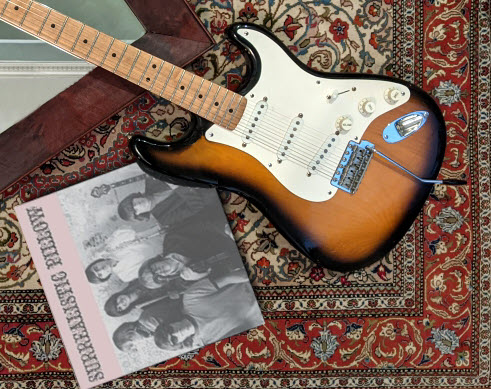
News
Feed Your Head!
Paul Mark Gives The Airplane's "White Rabbit" the Soul Strat Treatment
Feed Your Head!

The latest single from Paul Mark & The Van Dorens is a drastic makeover of the Jefferson Airplane’s psycho-profundo classic White Rabbit. The take-off point is Mark’s vintage Stratocaster sound that launches the trippy masterpiece into deep-soul guitar orbit.
“This cover track began as one of those closeted pandemic lock-down projects,” says Mark from his Manhattan studio. “After lining up a number of possible remakes White Rabbit seemed to be the most weirdly apt for a keep-it-under-3-minutes Strat workout. Catchy, familiar and ripe for a cockeyed string-bending lift off. I’d always had one little complaint about the original (don’t send me hate mail): the mix always seemed a bit off – the instrumental punch had been somewhat washed out and rendered too foggy.
“To feed my head I decided to retro-attack with a deep-soul guitar version, crisply mixed,” he added. “The idea of me singing on this track never entered the equation. That would’ve been like attempting to play the Frankenstein monster after watching Karloff’s performance.”
Lead singer Grace Slick had written and performed White Rabbit well before she joined Jefferson Airplane. But the first commercial pressing of her song was on the band’s 1966 album Surrealistic Pillow. In the decades since its release generations of listeners have wallowed in the track’s druggy Lewis Carrol ruminations and Alice’s allegorical search for logic in a looking glass world. The bolero rhythm – rarely heard in rock music – is a wicked compositional device, itself a sort of dervish-inducing hallucinogen. And Slick’s stagey enunciation of her cherry-picked Carroll quotes evokes the crazed rantings you hear in high-camp horror movies.
“I’ve always thought White Rabbit was hands-down the best single to come out of San Francisco in the 60s,” says Mark. “It’s as trippy-transcendent as anything even the Beatles or Dylan did in those heady years. Go ask Hunter Thompson – references to White Rabbit turn up like yesterday’s roaches in his writing.”
The lead instrument on the track is a 30-year old maple-necked tobacco-sunburst ’57 reissue Stratocaster.
“The guitar’s tricked out with oversized frets and Texas Special pickups which have extra coil windings to generate a slightly hotter tone,” adds Mark. “The guitar signal was split and channeled through several separately-mic’d amps, including a 1964 Fender Deluxe Reverb, all of which are blended in the final mix to achieve a hyper-clean classic-quack Strat sound. I aggressively played with my bare fingers (no pick used here) to get that pull-and-snap attack on the fretboard. As you can probably hear I was crazy-riding the whammy bar throughout. During the sessions I went through two tremolo bars and stripped the bar’s insertion threads in the bridge. Definitely a freeing approach to performance. But murder on the instrument…Guitar’s now in the shop.”
All instruments were recorded in Mark’s Manhattan home studio. A Fender Jazz Bass and a military field drum make up the basic rhythm track, along with an old Guild D25M acoustic guitar.
